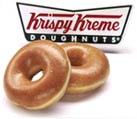 |
One company's target customer is a gourmand who likes natural food; the other's is a carbo-loader who needs a sugar fix. Together, they are two businesses that appeal to our fixations for great-tasting food, but do so from opposite ends of the spectrum -- the yin and yang of yum, you might say (or not).
  Whole Foods, the Austin, Texas-based grocery store chain, is America's largest purveyor of high-end specialty foods. When it opens in a new city, foodies flock from miles around to stroll aisles of perfect produce and marvelous meats. Whole Foods, the Austin, Texas-based grocery store chain, is America's largest purveyor of high-end specialty foods. When it opens in a new city, foodies flock from miles around to stroll aisles of perfect produce and marvelous meats.
Krispy Kreme, on the other hand, is a fast-growing peddler of that most elemental of comfort foods: the glazed doughnut. Its store openings trigger an analogous fervor among the faithful. Instead of swarming the cheese counter for hand-made Epoisses, however, the fried-dough fans are praying for a vision: The green "Hot Doughnuts Now" light flickering on. We rate the two in five categories.
|
|
-- By Gordon T. Anderson, CNN/Money Contributing Writer |
| |
| Size and reach |
 Revenues of $2.7 billion in its last fiscal year represent a better than 80 percent increase in five years. The company now has 144 stores, averaging 30,000 square feet each. Still, Whole Foods stores are in just 30 of the top 50 markets in the U.S., plus a store in Toronto. By the end of the decade, Whole Foods expects to have 300 stores, in all the major markets. The market cap is just more than $3 billion. Revenues of $2.7 billion in its last fiscal year represent a better than 80 percent increase in five years. The company now has 144 stores, averaging 30,000 square feet each. Still, Whole Foods stores are in just 30 of the top 50 markets in the U.S., plus a store in Toronto. By the end of the decade, Whole Foods expects to have 300 stores, in all the major markets. The market cap is just more than $3 billion.
|
 Revenues of $491 million in its latest fiscal year were a 25 percent improvement over the year before, and more than 170 percent greater than five years ago. The Krispy Kreme empire boasts 295 stores in 38 states, plus Canada and Australia. The company is also expanding into Mexico, New Zealand, and the United Kingdom. By the end of the decade, Krispy Kreme expects to have 600 outlets. The company's market cap is about $2.5 billion. Revenues of $491 million in its latest fiscal year were a 25 percent improvement over the year before, and more than 170 percent greater than five years ago. The Krispy Kreme empire boasts 295 stores in 38 states, plus Canada and Australia. The company is also expanding into Mexico, New Zealand, and the United Kingdom. By the end of the decade, Krispy Kreme expects to have 600 outlets. The company's market cap is about $2.5 billion.
|
 |
 |
| Expansion and growth |
 By buying rivals, building new stores, and pushing internal growth, Whole Foods has expanded at a heady clip over the past decade. Since the beginning of 2002, it's added 19 stores. Same-store sales for 2003 are expected to come in at the "low end" of a 6.5 percent to 8.5 percent growth range. By buying rivals, building new stores, and pushing internal growth, Whole Foods has expanded at a heady clip over the past decade. Since the beginning of 2002, it's added 19 stores. Same-store sales for 2003 are expected to come in at the "low end" of a 6.5 percent to 8.5 percent growth range.
|
 The company is selling franchises and opening new company-owned stores rapidly, with 74 outlets opening in the last year-and-a-half. Systemwide, comparable-store sales have risen between 9 percent and 10 percent in the last year. The company is selling franchises and opening new company-owned stores rapidly, with 74 outlets opening in the last year-and-a-half. Systemwide, comparable-store sales have risen between 9 percent and 10 percent in the last year.
|
 |
 |
| Performance and valuation |
 The stock (WFMI) is up about 40 percent since August 2002. At a recent $52, it trades at about 33 times trailing 12-months earnings. Standard & Poor's estimates WFMI will earn $1.65 per share this year, about 18 percent growth over last year. The stock (WFMI) is up about 40 percent since August 2002. At a recent $52, it trades at about 33 times trailing 12-months earnings. Standard & Poor's estimates WFMI will earn $1.65 per share this year, about 18 percent growth over last year.
|
 The stock (KKD) is up about 20 percent since August 2002. At a recent $44, it trades at 54 times trailing 12-month earnings of 56 cents per share. S&P estimates that KKD will earn 90 cents per share this year. It's smaller than Whole Foods in sales and earnings, but growing at a faster rate. The stock (KKD) is up about 20 percent since August 2002. At a recent $44, it trades at 54 times trailing 12-month earnings of 56 cents per share. S&P estimates that KKD will earn 90 cents per share this year. It's smaller than Whole Foods in sales and earnings, but growing at a faster rate.
|
 |
 |
| Icon status |
 When the first Whole Foods opened in Manhattan, the New York Times covered the event in multiple sections, and the New Yorker published a "Talk of the Town" about the guy who runs the store's checkout line. A marketing guru called the bountifully enticing stores "new spiritual Meccas" for foodies (who, apparently, don't consider old Mecca spiritual). When the first Whole Foods opened in Manhattan, the New York Times covered the event in multiple sections, and the New Yorker published a "Talk of the Town" about the guy who runs the store's checkout line. A marketing guru called the bountifully enticing stores "new spiritual Meccas" for foodies (who, apparently, don't consider old Mecca spiritual).
|
 The Smithsonian houses Krispy Kreme artifacts in its Americana collections. On the eve of store openings in a number of cities, including Boston, Philadelphia, and Fargo, N.D., as many as 250 aficionados have camped out in front of stores, in order to taste the first batch of doughnuts. InStyle magazine reported in 2002 on the trend of serving Krispy Kremes in lieu of cake at weddings. The Smithsonian houses Krispy Kreme artifacts in its Americana collections. On the eve of store openings in a number of cities, including Boston, Philadelphia, and Fargo, N.D., as many as 250 aficionados have camped out in front of stores, in order to taste the first batch of doughnuts. InStyle magazine reported in 2002 on the trend of serving Krispy Kremes in lieu of cake at weddings.
|
 |
 |
| Guilt factor |
 A serious food shopper can buy chanterelle mushrooms for $25 a pound, or morels for $30 if you want to splurge. A one-ounce bar of fine German chocolate costs $2.19. If you need a drink after seeing such prices, try the Belgian beer Westvleteren. A six-pack of the stuff goes for $48. But it's really, really nice. A serious food shopper can buy chanterelle mushrooms for $25 a pound, or morels for $30 if you want to splurge. A one-ounce bar of fine German chocolate costs $2.19. If you need a drink after seeing such prices, try the Belgian beer Westvleteren. A six-pack of the stuff goes for $48. But it's really, really nice.
|
 A single glazed Krispy Kreme contains 200 calories, 110 of which come from fat (12 grams). Before you finish chewing a second doughnut, you've exceeded the USDA's recommended fat intake for the entire day. If you keep eating, you should know that a box of 12 contains 144 grams of fat, and would likely entail a trip to the hospital. A single glazed Krispy Kreme contains 200 calories, 110 of which come from fat (12 grams). Before you finish chewing a second doughnut, you've exceeded the USDA's recommended fat intake for the entire day. If you keep eating, you should know that a box of 12 contains 144 grams of fat, and would likely entail a trip to the hospital.
|
 |
Tell us what you think...
|
|
|
 |

|

